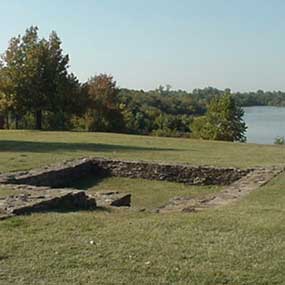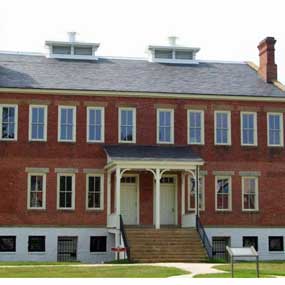 |
 | |
  | |
|
|
|
|
Fort Smith National Historic Site
Places
|
|
|
|
|
| |
 |
 |
| Fort Smith NHS | | Foundation of blockhouse at site of first Fort Smith overlooking Arkansas River |
 |
The first Fort Smith was established at the confluence of the Arkansas and Poteau Rivers in 1817 at a place called Belle Point. It was the highest navigable point on the Arkansas River at the time the site was chosen by the U.S. Army. The army abandoned the fort in 1824 and while used intermittently by transient troops it was never maintained. Its exact location remained unknown until 1963, when archeologists uncovered the foundations visitors can see today.
|
 |
| Fort Smith NHS | | Commissary Building |
 |
In 1838 a second fort was begun, this one built at a higher elevation away from the river. Major buildings included two officer's quarters, a barracks, commissary, and quartermaster storehouse, all enclosed by a stone wall. Today visitors can see the Commissary Storehouse, the oldest building still standing in Fort Smith, and the former military barracks which was converted into the federal courthouse in 1872.
An outline of stones placed at ground level marks the walls original location. Locations of other second fort buildings are designated by wayside panels and marked floor plans.
|
 |
| Fort Smith NHS | | Federal Courthouse |
 |
When the military barracks was used as a courthouse the basement was turned into a jail. In 1888 a new jail wing was constructed. The federal courthouse, which originally was a 1 1/2 story structure with full porches, was changed to its present appearance in 1890.
A reproduction of the 1886 gallows stands on its original site and is a reminder of the chaotic social conditions that existed in Indian Territory during Judge Parker's time.
|
|  |  |
|
|

Gallows
A reconstructed gallows stands on the site of the original structure.
more... | | 
Postcards of Second Fort Smith
Several postcards show views of what the fort looked like before 1870.
more... | | 
Postcards of Federal Court Era Buildings
Postcards of Fort Smith federal courthouses and jails
more... | |
|
|
|
|
|
|
|
 |
|
Did You Know?
The soldiers who came to Fort Smith in 1817 were still using some 18th century technology and drill. The cannon was discharged using a lindstock and slowmatch to ignite the primer, which originally was loose powder or a turkey quill filled with powder.
|
|
|
|
Last Updated: September 28, 2007 at 16:11 EST |






